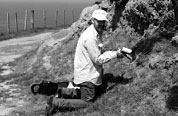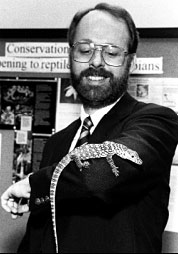Geoffrey Birchard, Ph.D. '86: Devoted to dragons
By Jonathan Weisberg
In legend and in literature, humans and dragons have always been at odds. Beowulf's last act of heroism, for example, was to stand against the charge of a marauding "wyrm." Unfortunately, both he and the dragon were killed in the conflict.
Now, thanks to modern biology, humans are trying to save dragons —especially the endangered Komodo dragon, the largest lizard in the world—through captive breeding programs. In 1992, the very first Komodo born in captivity outside of Indonesia was tended, studied, and nurtured through incubation and hatching by DMS graduate Geoffrey Birchard, Ph.D.
Birchard, an associate professor of biology at George Mason University in Fairfax, Va., and an expert in metabolism and gas transport in developing embryos, has incubated several clutches of Komodo dragons since then, but that first effort was a particular adventure. In 1991, Birchard was asked to take half of a 26-egg "clutch" from the National Zoo in Washington, D.C., because the zoo couldn't handle all of them. Birchard expected the Komodo eggs to hatch in about 100 days, since that's how long it usually takes for the eggs of another large reptile species—the python—to hatch. But as the Komodo eggs neared their 200th day, their shells remained uncracked.
As if the tension and suspense of awaiting the dragon hatchlings wasn't enough, the threat of FBI involvement was a constant worry. The Komodo eggs' parents had been a state gift from Indonesia, and that meant the eggs were federal property. Birchard was asked to keep his work secret and to allow only the National Zoo to handle any publicity. He was also warned that if anything happened to the eggs, the FBI would investigate. "I got very serious," Birchard says. He decided it would be wise to maintain total secrecy, and he only let one or two people know that the eggs were in his lab.

|
|
In the field, above, Birchard uses an infrared thermometer to measure the temperature of a tuatara burrow in New Zealand. At right, he shows off a baby Komodo dragon; this one is a couple of months old and weighs four or five pounds, but when fullgrown the animals can weigh up to 200 pounds. "Kraken is more like a dog than she is [like] most other lizards," Birchard says. She's a "very, very inquisitive animal." |
Then one Sunday morning, after 220 days of waiting, Birchard and his wife went to the lab to check on the eggs. "I was . . . opening up each of the boxes to see if anything had happened, and, since it had been so routine, we weren't expecting anything. But [I] opened up a box and suddenly [a baby dragon] . . . went scooting back inside her shell—just literally dived back in. You could see the tail sticking out." Birchard immediately notified the zoo. Before the zoo officials arrived, his wife had pinned an appropriate name on this very first baby dragon born in captivity—Kraken. Being named after this mythical sea monster was endearing when Kraken was small enough to sit on a person's arm; now, at 160 pounds, she has grown into her name. Komodos can top 10 feet in length and weigh up to 200 pounds. Kraken is actually something of a Web celebrity, and she can be viewed online via Web cam at http://zootv1.si.edu/demos.htm.
The reason why Komodos take so long to hatch, Birchard explains, "may be related to the fact that these animals have larger brains than most reptiles." As the first generation of hand-reared dragons has grown up, their handlers have seen indications of intelligence.
"Kraken is more like a dog than she is [like] most other lizards or snakes," he says. She's a "very, very inquisitive animal. . . . She also exhibits certain kinds of play behavior." When Kraken was younger, she would snatch notebooks out of her keeper's shirt pocket and retreat into her enclosure to tear them up. "Needless to say, this was hard on his shirts," Birchard says.
About half of Kraken's clutchmates hatched, and Birchard has studied the data on them as they've grown, calculating "the [metabolic] cost of growing a Komodo dragon." He also handled two more clutches after that first one and ran experiments on another. The hatch rate improved with each succeeding clutch, but this success eventually ended the breeding program because of fears that the mother might become genetically overrepresented in the worldwide Komodo population.
This "tremendous experience" was the beginning of a new emphasis in Birchard's career. Until his encounter with the dragons, Birchard had focused on "questions that are related to the fundamental understanding of certain processes, like gas transport in animals or understanding particular adaptations of species to extreme environments." Even as a boy, growing up in Lexington, Mass., he had been interested in how living creatures functioned. He went on to get his undergraduate degree in biology from Colorado College, a master's in zoology from the University of Montana, and his Ph.D. in physiology at Dartmouth. At DMS, Birchard worked with the respiratory physiology group under Marsh Tenney, M.D., and after completing his doctorate went on to George Mason, where he has been teaching and conducting research ever since.
Birchard says he finds his greatest satisfaction in the intellectual challenge of trying to solve physiological puzzles. "One of the problems I have been most interested in is the relationship between blood volume . . . and oxygen transport in animals. The relationship is more complex than I ever thought. . . . But it's beginning to integrate into a picture, and that, I think, is good."
To learn how animals cope with high levels of carbon dioxide and low levels of oxygen, he studied two burrow-dwelling animals—woodchucks and porcupines. Handling the porcupines added spice to that experiment and was riskier than raising dragon eggs, he says.
To understand oxygen transport, he studied the physiology of diving mammals and of animals that live at high altitudes. He has also done research on how an animal's size may regulate its temperature and blood circulation, and extrapolating his findings to very large beasts led him to look at dinosaurs. In fact, he has begun teaching a course on dinosaur biology, which allowed him (indeed, forced him) to learn all that he could about another nearly mythical beast.
He's studied so many different species of animals that Birchard has a hard time recalling them all—"everything from porcupines and woodchucks to rats and rabbits . . . Komodo dragons to cobra eggs to snapping turtles . . . all sorts of species of different birds . . . and cockroaches." He admits that he has fun with any kind of critter. "I'm a biologist, and I like animals."
Birchard says he has to do a "huge amount of reading" to stay current in his fields. "I do everything from teaching physiology, to a course in dinosaur biology, [to] conservation—and those are three different things—so I'm occupied with books a lot." Whenever he has free time, he'll pick a nonscientific book off the shelf—usually historical fiction, science fiction, or biography—and read for pleasure. Birchard's other primary hobby is fortunately one that is in part satisfied by his work. "I like to . . . watch animals," he says. "I spend a lot of time when I travel . . . going to zoos and museums and wildlife areas." But although he enjoys seeing exotic species elsewhere, he is also just as happy sitting on his own porch and watching the birds.
Ever since he cared for those tiny dragons, Birchard has become more interested in work that furthers conservation. He regularly consults with the National Zoo's Conservation and Research Center, a facility located in western Virginia and dedicated to raising endangered species and sustaining populations of gazelles, leopards, Hawaiian birds, and other at-risk animals. "I have a role in conservation biology that I play career-wise. . . . It's important to me as a biologist—sort of taking your own expertise and applying it where you can," he says.
It was in this role as a conservation biologist that Birchard traveled to New Zealand in 1998 and collaborated with scientists studying the tuatara, a highly endangered lizard that lives only on several offshore islands. The two species of tuatara, the only representatives of their taxonomic family, are notable for their "third eye," a highly developed pineal gland that is photosensitive and detects daily and seasonal rhythms.

|
|
Photo: Courtesy National Zoo |
But what was to have been a year's sabbatical ended prematurely. The first time Birchard visited the rugged, volcanic islands where the tuatara live, he leapt from his boat to the rocky shore and broke his ankle. Before he had a chance to see a single tuatara, he had to be helicoptered off the island.
Fortunately, he was able to resume his sabbatical the following year and, this time, spotted the animals in the wild. The tuatara are largely nocturnal. "So you're out with headlamps on at night, running around on this island, and listening to the surf crash down on the cliffs below you," says Birchard. "It's kind of a fun thing to do."
He wanted to understand the tuatara's thermal biology, since much of their activity is determined by temperature. The tuatara spend most of their time in burrows, so Birchard decided to compare the temperature inside their burrows to that of the ambient air. Then he discovered a complication —seabirds often live in the same burrows. "If a bird is in the burrow, it's like having a little heater in [there]. The temperature of those burrows is not only buffered from the extremes, but they tend to be generally warmer than burrows without birds." Birchard's finding that the tuatara are less cold-adapted than previously thought may facilitate efforts to raise them for reintroduction programs and to sustain them in the wild.
Birchard maintains an ongoing interest in these creatures and would love an opportunity to return to the land of the tuatara. "New Zealand is a magnificent country," he says. "The tuatara is just one of any number of very rare and special species." He is clearly engaged by the effort to discover and then apply knowledge about the physiology of living things. It's the branching path of inquiry he has followed throughout his career.
If Birchard encountered Beowulf's "wyrm," he'd probably devise an experiment to study gas transport in its fiery maw.
Weisberg, a 1996 Dartmouth graduate, is Dartmouth Medicine's editorial assistant.
Back to Dartmouth Medicine Summer 2000
